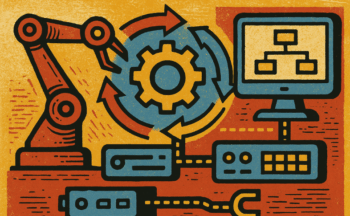Artificial Intelligence is a present reality transforming how businesses operate. But while the hype focuses on tools, the real challenge lies in people: who has the skills to guide AI adoption in ways that save time, generate revenue, and manage risks? Two roles stand out as indispensable. The Digital Transformation Consultant (AI Strategist) provides the vision and blueprint, ensuring AI is a disciplined investment rather than a gamble. The Business Process Analyst (AI/RPA) translates that vision into reality, redesigning workflows so humans focus on creativity while automation handles the repetitive.
This is where Way We Do’s Process Management Platform makes the difference. It helps strategists document the decision frameworks and governance models that anchor AI adoption, while giving analysts the tools to map, automate, and embed processes directly into daily workflows. Together, these roles — and the systems that support them — turn AI from a buzzword into a business advantage.
Let’s take a look at these two roles and the AI skills needed further…
1. The AI Strategist (aka Digital Transformation Consultant)
Eighty-five percent of AI projects fail, not because of technology, but because companies lack a clear strategy. Too many firms chase shiny tools without asking the fundamental questions: Where does AI save us time? Where does it make us money? Where could it go wrong?
The Digital Transformation Consultant — or AI Strategist — is the role designed to answer those questions. Like an architect drafting blueprints before construction begins, they create the roadmap for how a business can use AI to save money, increase revenue, and manage risks. Their work is not about recommending tools. It is about designing the entire decision architecture:
- Which processes should be automated?
- What metrics define success?
- Where do the ethical, operational, and financial risks lie?
- How do we measure return on investment in real terms?
According to McKinsey, only 30% of consulting tasks can be fully automated in the next decade. The rest requires human judgment, context, and trust. That gap is where the AI Strategist operates. Their toolkit includes adoption roadmaps, ROI models, readiness assessments, governance frameworks, risk audits, and compliance guidance. They are the ones executives turn to when deciding: If we invest $5 million into AI, how much time or money do we save? How much new revenue will it generate? And what hidden costs should we anticipate?
Digital Transformation Strategists with a financial background often transition well into this role, since the work blends business foresight with quantitative modeling.
Case Study
Consider IBM. Rather than scatter pilot projects across departments, the company partnered with BCG to develop a comprehensive AI transformation strategy. The focus was not on experimenting with the latest chatbot, but on systematically applying AI to support functions such as legal, IT, HR, and procurement. The results were dramatic: $3.5 billion in cost savings and a 50% increase in productivity over just two years. For a company already operating at global scale, those gains were nothing short of transformative.
In an economy defined by speed and outcomes, the Digital Transformation Consultant / AI Strategist is no longer optional. They are the ones who ensure AI adoption is not a gamble but a disciplined investment — anchored to real business goals, measurable returns, and long-term resilience.
2. The Business Process Analyst (AI/RPA)
If the strategist designs the blueprint, the Business Process Analyst who specializes in business process management is the one who brings it to life. Their mission is to analyze how work actually flows through an organization and then re-architect those processes so that humans focus on judgment and creativity while AI and robotic process automation (RPA) handle the repetitive and mechanical.
This role is not about duct-taping software tools together. It is about systematically redesigning the way a business runs — much like a city planner reconfiguring a traffic network. When intersections are clogged and commuters are stuck in gridlock, the planner studies patterns, redesigns routes, adds signals, and builds bypasses. Suddenly, what was once chaotic becomes fluid. The same happens inside companies: broken workflows waste time and frustrate staff until an analyst steps in to untangle the system.
Studies by McKinsey and Deloitte consistently show that most productivity gains in the AI era do not come from deploying shiny new platforms, but from rethinking the workflows that run beneath them. Yet this is exactly where most companies struggle. They do not have broken technology. They have broken processes. AI alone cannot map a messy workflow or navigate the politics of a team. A Business Process Analyst, equipped with both technical skills and human insight, can.
The work often begins with a process audit: documenting the current state, mapping every step, and identifying what is manual, what is redundant, and what adds true value. From there, the analyst designs a “future state” workflow — one where AI agents, RPA scripts, and platforms like Microsoft Power Automate or Zapier handle repetitive steps, while employees focus on decisions, creativity, and relationship-building. Crucially, they also define clear KPIs so leaders can measure the success of the transformation.
Common processes that benefit from this redesign include employee onboarding, invoicing, and customer support. Each is rich in repetitive tasks that consume hours but add little strategic value. By automating the routine, businesses unlock scalability and resilience.
Case Study
Consider a mid-size marketing agency where account managers once spent up to three hours manually onboarding each new client. A Business Process Analyst mapped the workflow and automated 60% of the repetitive steps — using Zapier for data entry, Microsoft Power Automate for document routing, and AI integrations for proposal generation. The result: onboarding time fell from three hours to one, and manual effort dropped by 70%. For a company juggling dozens of new clients each month, the impact was transformative — faster scaling, leaner teams, and more time for high-value client strategy.
In an era where speed and outcomes define competitiveness, the Business Process Analyst has become indispensable. They are the translators between vision and execution, ensuring that automation delivers not only efficiency but also a new way of working — one that is more human, not less.
Making AI Skills Work For You
AI adoption is not simply about plugging in the latest software — it’s about aligning people, processes, and strategy. The AI Strategist ensures that businesses make smart, disciplined investments, while the Business Process Analyst transforms those strategies into seamless workflows that balance automation with human creativity.
Yet even the best talent needs the right platform to succeed. That’s where Way We Do’s Process Management Platform comes in. By providing a single place to document strategies, map workflows, embed automation, and ensure compliance, Way We Do enables these roles to deliver measurable results. It turns AI projects from risky experiments into repeatable systems of productivity, growth, and resilience.
For organizations ready to move beyond AI hype and build lasting capability, the path is clear: empower your strategists, support your analysts, and equip them with the tools to make change stick. With the right people and the right platform, AI stops being a buzzword — and starts becoming your competitive edge.





